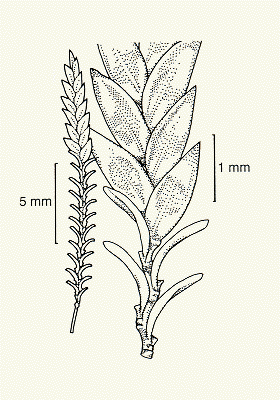Eragrostis petraea M.
Lazarides. Austral. Syst. Bot.
10: 141 (1997).
Classification. (GPWG 2001) : Subfamily
Chloridoideae. Cynodonteae.
Type of Basionym or
Protologue Information: Australia,
Darwin & Gulf district: Lazarides
8841 (CANB holo, B, DNA, G, L, MEL, NSW, PERTH, PRE).
Key references
(books and floras): [2002] D.Sharp & B.K.Simon, AusGrass, Grasses of
Australia.
Illustrations:
[2005] K.Mallet (ed.), Flora of Australia 44B: Poaceae 3
(Fig. 68P-Q).
Habit.
Perennial. Culms erect, 70–150 cm tall, 4 -noded. Leaf-sheaths smooth, glabrous
on surface. Ligule a fringe of hairs, 0.2–0.3 mm long. Leaf-blades straight,
flat or involute or convolute, 15–30 cm long, 2–4.4 mm wide. Leaf-blade surface
scabrous, glabrous.
Inflorescence.
Inflorescence compound, a panicle. Panicle ovate, effuse, 20–46 cm long, 8–16
cm wide.
Spikelets.
Spikelets pedicelled. Fertile spikelets many flowered, with at least 2 fertile
florets (38–55), comprising 1 basal sterile florets, comprising 38–55 fertile
floret(s), with diminished florets at the apex, linear, laterally compressed,
16–27 mm long. Rhachilla internodes elongated between glumes.
Glumes. Glumes
similar. Lower glume linear or oblong, membranous, without keels, 0–1 -nerved.
Upper glume lanceolate, 0.6–1.2 mm long, membranous, keeled, 1-keeled, 1
-nerved. Upper glume apex muticous. Florets. Basal sterile florets 1,
barren. Lemma of lower sterile floret 1 -nerved.
Fertile lemma 1.5–2 mm
long, keeled, 3 -nerved. Palea 2 -nerved. Anthers 3. Grain 0.5–0.6 mm long.
Continental
Distribution: Australasia.
Australian
Distribution: Western Australia, Northern Territory.
Western
Australia: Gardner.
Northern Territory:
Darwin & Gulf.
Notes.
Distinguishing characters include open decompound scabrous panicle; first
floret reduced to a nerveless lemma resembling upper glume; dissimilar glumes,
separated by an internode; semi-persistent straight, thickened rachilla and
distinctive caryopsis.
Endemic;
Kakadu Natl Park,
N.T. Rocky hills.; flowers May-June; fruits May-June.




